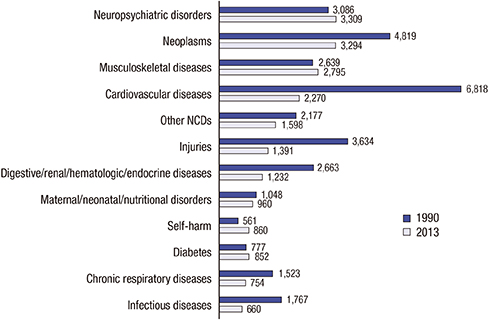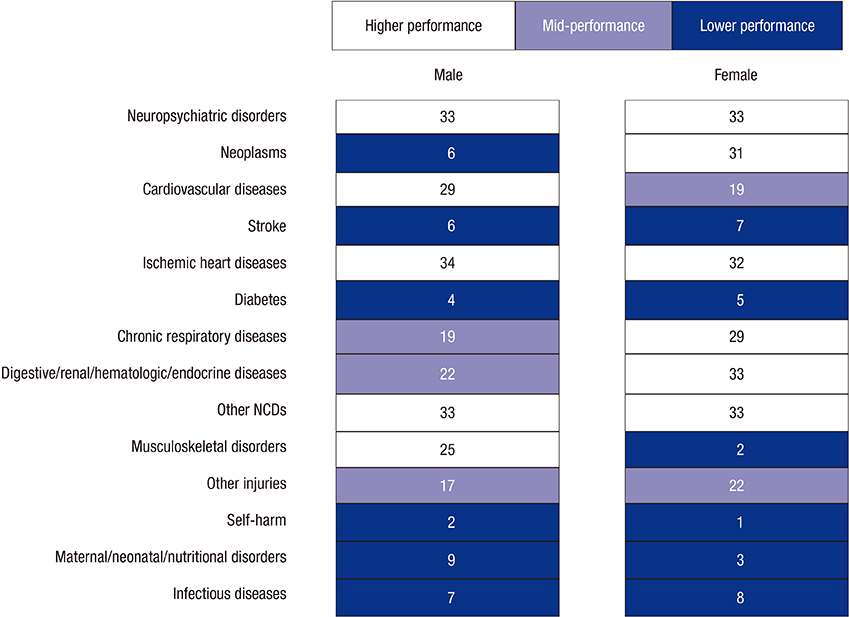J Korean Med Sci.
2016 Nov;31(Suppl 2):S114-S120. 10.3346/jkms.2016.31.S2.S114.
Health Performance and Challenges in Korea: a Review of the Global Burden of Disease Study 2013
- Affiliations
-
- 1Department of Public Healthcare Services, Seoul Bukbu Hospital, Seoul, Korea.
- 2Department of Preventive Medicine, College of Medicine, Korea University, Seoul, Korea. yoonsj02@korea.ac.kr
- 3Department of Public Health, Graduate School, Korea University, Seoul, Korea.
- KMID: 2360661
- DOI: http://doi.org/10.3346/jkms.2016.31.S2.S114
Abstract
- The global burden of disease study (GBD) provides valuable information for evaluating population health in terms of disease burden. This study collected and reviewed GBD data in Korea for the year 1990 and 2013. The burdens of cancer, cardiovascular disease, communicable disease, and injuries have decreased remarkably, thereby greatly diminishing the overall disease burden on Korea. Meanwhile, the burdens due to non-fatal chronic diseases such as neuropsychiatric and musculoskeletal disease became major burden contributors. Responding to this circumstance presents a complex challenge to the Korean health system and Korean health policy.
MeSH Terms
Figure
Cited by 2 articles
-
Updates on Cancer Epidemiology in Korea, 2018
Sun-Seog Kweon
Chonnam Med J. 2018;54(2):90-100. doi: 10.4068/cmj.2018.54.2.90.Association of Insulin, Metformin, and Statin with Mortality in Breast Cancer Patients
Mihong Choi, Jiyeon Han, Bo Ram Yang, Myoung-jin Jang, Miso Kim, Dae-Won Lee, Tae-Yong Kim, Seock-Ah Im, Han-Byoel Lee, Hyeong-Gon Moon, Wonshik Han, Dong-Young Noh, Kyung-Hun Lee
Cancer Res Treat. 2021;53(1):65-76. doi: 10.4143/crt.2020.430.
Reference
-
1. Korean Statistical Information Service. Abridged life tables 1970-2014 [Internet]. accessed on 1 December 2015. Available at http://kosis.kr/eng/statisticsList/statisticsList_01List.jsp?vwcd=MT_ETITLE&parentId=A#SubCont.2. Yang S, Khang YH, Harper S, Davey Smith G, Leon DA, Lynch J. Understanding the rapid increase in life expectancy in South Korea. Am J Public Health. 2010; 100:896–903.3. Lim D, Ha M, Song I. Trends in the leading causes of death in Korea, 1983-2012. J Korean Med Sci. 2014; 29:1597–1603.4. Weisz G, Olszynko-Gryn J. The theory of epidemiologic transition: the origins of a citation classic. J Hist Med Allied Sci. 2010; 65:287–326.5. Murray CJ, Barber RM, Foreman KJ, Abbasoglu Ozgoren A, Abd-Allah F, Abera SF, Aboyans V, Abraham JP, Abubakar I, Abu-Raddad LJ, et al. Global, regional, and national disability-adjusted life years (DALYs) for 306 diseases and injuries and healthy life expectancy (HALE) for 188 countries, 1990-2013: quantifying the epidemiological transition. Lancet. 2015; 386:2145–2191.6. Khang YH. Burden of noncommunicable diseases and national strategies to control them in Korea. J Prev Med Public Health. 2013; 46:155–164.7. Murray CJ, Lopez AD. Measuring the global burden of disease. N Engl J Med. 2013; 369:448–457.8. GBD 2013 Mortality and Causes of Death Collaborators. Global, regional, and national age-sex specific all-cause and cause-specific mortality for 240 causes of death, 1990-2013: a systematic analysis for the global burden of disease study 2013. Lancet. 2015; 385:117–171.9. Global Burden of Disease Study 2013 Collaborators. Global, regional, and national incidence, prevalence, and years lived with disability for 301 acute and chronic diseases and injuries in 188 countries, 1990-2013: a systematic analysis for the global burden of disease study 2013. Lancet. 2015; 386:743–800.10. Institute for Health Metrics and Evaluation (IHME). GBD compare [Internet]. accessed on 1 December 2015. Available at http://vizhub.healthdata.org/gbd-compare.11. Lim D, Ha M, Song I. Trends in major cancer mortality in Korea, 1983-2012, with a joinpoint analysis. Cancer Epidemiol. 2015; 39:939–946.12. Jung KW, Shin HR, Kong HJ, Park S, Won YJ, Choi KS, Park EC. Long-term trends in cancer mortality in Korea (1983-2007): a joinpoint regression analysis. Asian Pac J Cancer Prev. 2010; 11:1451–1457.13. Korean Statistical Information Service. Death and death rates by casuse [Internet]. accessed on 1 December 2015. Available at http://kosis.kr/eng/statisticsList/statisticsList_01List.jsp?vwcd=MT_ETITLE&parentId=A#SubCont.14. Organisation for Economic Cooperation and Development. OECD health statistics [Internet]. accessed on 1 December 2015. Available at http://stats.oecd.org/index.aspx?DataSetCode=HEALTH_STAT.15. Yeo Y, Gwack J, Kang S, Koo B, Jung SJ, Dhamala P, Ko KP, Lim YK, Yoo KY. Viral hepatitis and liver cancer in Korea: an epidemiological perspective. Asian Pac J Cancer Prev. 2013; 14:6227–6231.16. Hoy DG, Smith E, Cross M, Sanchez-Riera L, Blyth FM, Buchbinder R, Woolf AD, Driscoll T, Brooks P, March LM. Reflecting on the global burden of musculoskeletal conditions: lessons learnt from the global burden of disease 2010 study and the next steps forward. Ann Rheum Dis. 2015; 74:4–7.17. Shepard D, VanderZanden A, Moran A, Naghavi M, Murray C, Roth G. Ischemic heart disease worldwide, 1990 to 2013: estimates from the global burden of disease study 2013. Circ Cardiovasc Qual Outcomes. 2015; 8:455–456.18. Krishnamurthi RV, Feigin VL, Forouzanfar MH, Mensah GA, Connor M, Bennett DA, Moran AE, Sacco RL, Anderson LM, Truelsen T, et al. Global and regional burden of first-ever ischaemic and haemorrhagic stroke during 1990-2010: findings from the global burden of disease study 2010. Lancet Glob Health. 2013; 1:e259–e281.19. World Health Organization. World health statistics 2015 [Internet]. accessed on 1 December 2015. Available at http://apps.who.int/iris/bitstream/10665/170250/1/9789240694439_eng.pdf?ua=1&ua=1.20. Storheim K, Zwart JA. Musculoskeletal disorders and the global burden of disease study. Ann Rheum Dis. 2014; 73:949–950.21. Patten SB. The global burden of disease 2010 update: keeping mental health in the spotlight. Epidemiol Psychiatr Sci. 2014; 23:255–257.22. Organisation for Economic Cooperation and Development. Korea's increase in suicides and psychiatric bed numbers is worrying, says OECD [Internet]. accessed on 1 December 2015. Available at http://www.oecd.org/els/health-systems/MMHC-Country-Press-Note-Korea.pdf.23. GBD 2013 Risk Factors Collaborators. Forouzanfar MH, Alexander L, Anderson HR, Bachman VF, Biryukov S, Brauer M, Burnett R, Casey D, Coates MM, et al. Global, regional, and national comparative risk assessment of 79 behavioural, environmental and occupational, and metabolic risks or clusters of risks in 188 countries, 1990-2013: a systematic analysis for the global burden of disease study 2013. Lancet. 2015; 386:2287–2323.24. Roth GA, Nguyen G, Forouzanfar MH, Mokdad AH, Naghavi M, Murray CJ. Estimates of global and regional premature cardiovascular mortality in 2025. Circulation. 2015; 132:1270–1282.25. Kang YW, Ko YS, Kim KY, Sung C, Lee DH, Jeong E. Trends in health-related behaviors of Korean adults: study based on data from the 2008-2014 Community Health Surveys. Epidemiol Health. 2015; 37:e2015042.26. Khang YH, Lynch JW, Jung-Choi K, Cho HJ. Explaining age-specific inequalities in mortality from all causes, cardiovascular disease and ischaemic heart disease among South Korean male public servants: relative and absolute perspectives. Heart. 2008; 94:75–82.27. Cho HJ. The status and future challenges of tobacco control policy in Korea. J Prev Med Public Health. 2014; 47:129–135.28. Ohn JH, Kwak SH, Cho YM, Lim S, Jang HC, Park KS, Cho NH. 10-year trajectory of beta-cell function and insulin sensitivity in the development of type 2 diabetes: a community-based prospective cohort study. Lancet Diabetes Endocrinol. 2016; 4:27–34.29. Ha KH, Kim DJ. Trends in the diabetes epidemic in Korea. Endocrinol Metab (Seoul). 2015; 30:142–146.30. Jung JH, Lee JH, Noh JW, Park JE, Kim HS, Yoo JW, Song BR, Lee JR, Hong MH, Jang HM, et al. Current status of management in type 2 diabetes mellitus at general hospitals in South Korea. Diabetes Metab J. 2015; 39:307–315.31. Atun R. Transitioning health systems for multimorbidity. Lancet. 2015; 386:721–722.32. Bert F, Scaioli G, Gualano MR, Siliquini R. How can we bring public health in all policies? Strategies for healthy societies. J Public Health Res. 2015; 4:393.33. Byass P, de Courten M, Graham WJ, Laflamme L, McCaw-Binns A, Sankoh OA, Tollman SM, Zaba B. Reflections on the global burden of disease 2010 estimates. PLoS Med. 2013; 10:e1001477.34. Nord E. Disability weights in the global burden of disease 2010: unclear meaning and overstatement of international agreement. Health Policy. 2013; 111:99–104.35. Burstein R, Fleming T, Haagsma J, Salomon JA, Vos T, Murray CJ. Estimating distributions of health state severity for the global burden of disease study. Popul Health Metr. 2015; 13:31.
- Full Text Links
- Actions
-
Cited
- CITED
-
- Close
- Share
- Similar articles
-
- Burden of Disease in Japan: Using National and Subnational Data to Inform Local Health Policy
- Health Economic Approach on Mental Health in Korea
- Controlling the drug-resistant tuberculosis epidemic in India: challenges and implications
- The Korean National Burden of Disease Study: from Evidence to Policy
- Consensus on global health competencies for Korean medical students using a modified Delphi method





